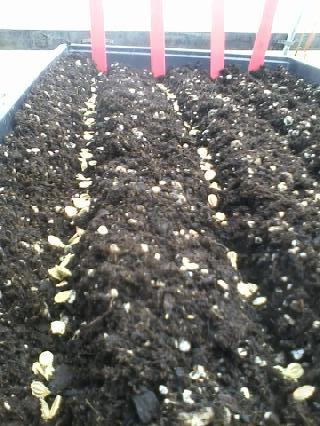I have worked on farms before. When I was in high school, I would sometimes wander over to my friend’s farm in Corrales, New Mexico to help with weeding, planting, harvest and washing. I would often arrive barefoot and he clearly though I was crazy for this.
I’ve lived on a homestead in southern Colorado where I learned about cows, horses and ridge and furrow farming. I’ve helped to milk goats and make cheese in the middle of the New Mexico desert. I worked on the harvest crew of a farm named after a dog in the Chimacum valley of the Olympic Peninsula. Most recently I worked the full season at a small CSA farm in Olympia, WA.
And yet, despite my return to farm work, I have never really wanted to be a farmer – to actually own a farm. It scares the nomadic part of me.
At Red Dog Farm in Chimacum, the “unfortunate” discovery that I’m allergic to the mold that grows on strawberries allowed me to join the flower harvest team – my first small glimpse into flower production. I snipped and collected large armfuls of zinnias and sunflowers and put them in buckets. I learned that the smell from the center of sunflowers transports me to some unknown childhood memory. There was a debate between members of the farm crew about the importance growing flowers on the farm. Some argued it was arbitrary and tedious – they didn’t want anything to do with them. Flowers don’t serve a real purpose, they’d say. You can’t be nourished from flowers in the same way as vegetables. At the time I didn’t have a good counter argument – but I did know that I loved working with flowers.
Since then I have passively chewed on the idea of growing flowers. Pipe dreaming of a small flower farm in New Mexico. And then, after browsing the spring 2017 Evergreen catalogue, the thought occurred to me – why not use this quarter as an opportunity to explore this interest that already lines up with my focus of food systems and community. I emailed August Farm, having no idea if they’d be receptive to hosting me as an intern – and here we are.
August Farm is a Female owned and run livestock and cut flower farm in Rochester, Washington. Their animals are pasture-raised and eat a combination of grass and local, organic feed. The flowers are grown using chemical-free methods.
I drove out to August Farm for the first time on March 28th for a working interview. I took the back roads from Olympia and only got a little bit lost. Marianne and Liza invited me into their house and offered me a cup of tea. We talked past experiences and each of our goals and desires for the internship. I followed them out to “the land trust” – a property a couple of miles down the road that they are using to grow the bulk of their flowers this year. They have expanded they production by double this year, now growing one full acre of flowers.
This property is owned by South of the Sound Community Farm Land Trust and in partnership with Kirsop Farm, Creekside Conservancy and Eterprise for Equity, offers long-term, inheritable leases to qualified farmers. August Farm gets to use 1/3 of the big high tunnel and about ____ of the field.
Once there, we hand-weeded, wheel-hoed and set up drip irrigation in the high tunnel. I then got a small tour of the caterpillar houses, which are currently housing anemones as well as Kirsop’s greenhouses (just for fun).
Other work during the first week included:
April 3rd
Amending beds at land trust property with lime powder. Liza said she thinks the soil pH there is about 5 or 6 which is better than the soil at their property. Mar tilled that in while Lydia (the full-time farm intern this season) and I worked on removing the wiggle wire from the high tunnel and reinstalling it into a roller system. This was the first sunny day in a while so we planted so many flower babies including snap dragons, stock and sweet peas.
At lunch Mar, Lydia and I talked about so many interesting things. Mar shared a bit about her journey of feeling validation in doing what they do and about using privilege and not getting stuck in an apologetic mindset.
How to make a “luxury item” more equally accessible?
- flower installations: wanting to do more guerilla flower art, a flower rejuvenation tent for folks living on the street.
- Hospice donation
- How else??
April 5th&6th
So much greenhouse work! It’s nice to be able to still feel productive while being sheltered from the rain. I’m beginning to learn their greenhouse system and where everything is. There’s a big mouse problem this year – they eat the seeds and cotyledons and sometimes just rip the seedlings out of the soil.
Tasks included:
- Up-potting from trays into 128s and 72s.
- Pricking out zinnias
- Seeding (grasses, strawflower, sunflowers…
- Watering
- Bringing trays down from house/moving starts from farm greenhouse to land trust.
- Labeling



Be First to Comment